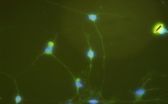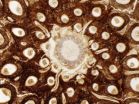(Press-News.org) Critical illness polyneuropathy and critical illness myopathy are frequent complications of severe illness that involve sensorimotor axons and skeletal muscles, respectively. Differentiating critical illness polyneuropathy from Guillain-Barré syndrome, especially the axonal variants, may be difficult on purely clinical grounds, as Guillain-Barré syndrome is known for its variable atypical manifestations. Prof. Hongliang Zhang and team from the First Bethune Hospital, Jilin University in China provide the latest knowledge concerning the pathophysiology of critical illness polyneuropathy/myopathy along with relevant clinical, diagnostic, differentiating, and treatment information for this debilitating neurological disease, and underscores the importance of differentiating critical illness polyneuropathy and myopathy from Guillain-Barré syndrome. The relevant paper was published in the Neural Regeneration Research (Vol. 9, No. 1, 2014).
INFORMATION:
Article: "Critical illness polyneuropathy and myopathy: a systematic review " by Chunkui Zhou1, 2, Limin Wu1, 3, Fengming Ni4, Wei Ji5, Jiang Wu1, Hongliang Zhang1 (1 Department of Neurology, the First Bethune Hospital, Jilin University, Changchun 130021, Jilin Province, China; 2 Department of Neurology, the Second Part, the First Bethune Hospital, Jilin University, Changchun 130021, Jilin Province, China; 3 Neuroprotection Research Laboratory, Massachusetts General Hospital, Harvard Medical School, Charlestown 02129, MA, USA; 4 Department of Radiotherapy, Oncology Center, the First Bethune Hospital, Jilin University, Changchun 130021, Jilin Province, China; 5 Department of Vascular Surgery, People's Hospital of Jilin Province, Changchun 130000, Jilin Province, China)
Zhou CK, Wu LM, Ni FM, Ji W, Wu J, Zhang HL. Critical illness polyneuropathy and myopathy: a systematic review. Neural Regen Res. 2014;9(1):101-110.
Contact: Meng Zhao
eic@nrren.org
86-138-049-98773
Neural Regeneration Research
http://www.nrronline.org/
Critical illness polyneuropathy and myopathy: Nerve injury and regeneration
2014-03-21
ELSE PRESS RELEASES FROM THIS DATE:
Lessons offered by emerging carbon trading markets
2014-03-21
DURHAM, N.C. -- Although markets for trading carbon emission credits to reduce greenhouse gas emissions have stalled in United States federal policy-making, carbon markets are emerging at the state level within the U.S. and around the world, teaching us more about what does and doesn't work.
In a Policy Forum article in the March 21 edition of Science magazine, Duke University's Richard Newell, William Pizer and Daniel Raimi discuss the key lessons from a decade of experience with carbon markets. They also discuss what it might take for these markets to develop and possibly ...
Who reprograms rat astrocytes into neurons?
2014-03-21
To date, it remains poorly understood whether astrocytes can be easily reprogrammed into neurons. Mash1 and Brn2 have been previously shown to cooperate to reprogram fibroblasts into neurons. Dr. Yongjun Wang and team from Shanghai University of Traditional Chinese Medicine in China found that and found that Brn2 was expressed in astrocytes from 2-month-old Sprague-Dawley rats, but Mash1 was not detectable. Thus, the researchers hypothesized that Mash1 alone could be used to reprogram astrocytes into neurons. Murine stem cell virus (MSCV)-Mash1 recombinant plasmid was constructed ...
Unique chromosomes preserved in Swedish fossil
2014-03-21
Researchers from Lund University and the Swedish Museum of Natural History have made a unique discovery in a well-preserved fern that lived 180 million years ago. Both undestroyed cell nuclei and individual chromosomes have been found in the plant fossil, thanks to its sudden burial in a volcanic eruption.
The well-preserved fossil of a fern from the southern Swedish county of Skåne is now attracting attention in the research community. The plant lived around 180 million years ago, during the Jurassic period, when Skåne was a tropical region where the fauna was dominated ...
A study using Drosophila flies reveals new regulatory mechanisms of cell migration
2014-03-21
Cell migration is highly coordinated and occurs in processes such as embryonic development, wound healing, the formation of new blood vessels, and tumour cell invasion. For the successful control of cell movement, this process has to be determined and maintained with great precision. In this study, the scientists used tracheal cells of the fruit fly Drosophila melanogaster to unravel the signalling mechanism involved in the regulation of cell movements.
The research describes a new molecular component that controls the expression of a molecule named Fibroblast Growth ...
Switching an antibiotic on and off with light
2014-03-21
This news release is available in German. Scientists of the KIT and the University of Kiev have produced an antibiotic, whose biological activity can be controlled with light. Thanks to the robust diarylethene photoswitch, the antimicrobial effect of the peptide mimetic can be applied in a spatially and temporally specific manner. This might open up new options for the treatment of local infections, as side effects are reduced. The researchers present their photoactivable antibiotic with the new photomodule in a "Very Important Paper" of the journal "Angewandte Chemie". ...
cfaed presents the new microchip 'Tomahawk 2' at the DATE'14 in Dresden
2014-03-21
The Center for Advancing Electronics Dresden (cfaed) presents its new microchip 'Tomahawk 2' at the DATE'14 Conference in the International Congress Center Dresden from March 24 to 28, 2014. The new Tomahawk is extremely fast, energy-efficient and resilient. It is a heterogeneous multi-processor which can easily integrate very different kinds of devices. The researchers of the Cluster of Excellence for microelectronics of Technische Universität Dresden use the new prototype to prepare the so-called 'tactile internet'. With this, very big data volumes shall be transmitted ...
New study shows we work harder when we are happy
2014-03-21
Happiness makes people more productive at work, according to the latest research from the University of Warwick.
Economists carried out a number of experiments to test the idea that happy employees work harder. In the laboratory, they found happiness made people around 12% more productive.
Professor Andrew Oswald, Dr Eugenio Proto and Dr Daniel Sgroi from the Department of Economics at the University of Warwick led the research.
This is the first causal evidence using randomized trials and piece-rate working. The study, to be published in the Journal of Labor Economics, ...
Surprising new way to kill cancer cells
2014-03-21
Northwestern Medicine scientists have demonstrated that cancer cells – and not normal cells – can be killed by eliminating either the FAS receptor, also known as CD95, or its binding component, CD95 ligand.
"The discovery seems counterintuitive because CD95 has previously been defined as a tumor suppressor," said lead investigator Marcus Peter, professor in medicine-hematology/Oncology at Northwestern University Feinberg School of Medicine. "But when we removed it from cancer cells, rather than proliferate, they died."
The findings were published March 20 in Cell Reports. ...
Stem cell study finds source of earliest blood cells during development
2014-03-21
Irvine, Calif., March 20, 2014 — Hematopoietic stem cells are now routinely used to treat patients with cancers and other disorders of the blood and immune systems, but researchers knew little about the progenitor cells that give rise to them during embryonic development.
In a study published April 8 in Stem Cell Reports, Matthew Inlay of the Sue & Bill Gross Stem Cell Research Center and Stanford University colleagues created novel cell assays that identified the earliest arising HSC precursors based on their ability to generate all major blood cell types (red blood ...
New infrared technique aims to remotely detect dangerous materials
2014-03-21
For most people, infrared technology calls to mind soldiers with night-vision goggles or energy audits that identify where heat escapes from homes during the winter season.
But for two Brigham Young University professors, infrared holds the potential to spot from afar whether a site is being used to make nuclear weapons.
Statistics professor Candace Berrett developed a model that precisely characterizes the material in each pixel of an image taken from a long-wave infrared camera. The U.S. National Nuclear Security Administration funded the project through a grant ...



